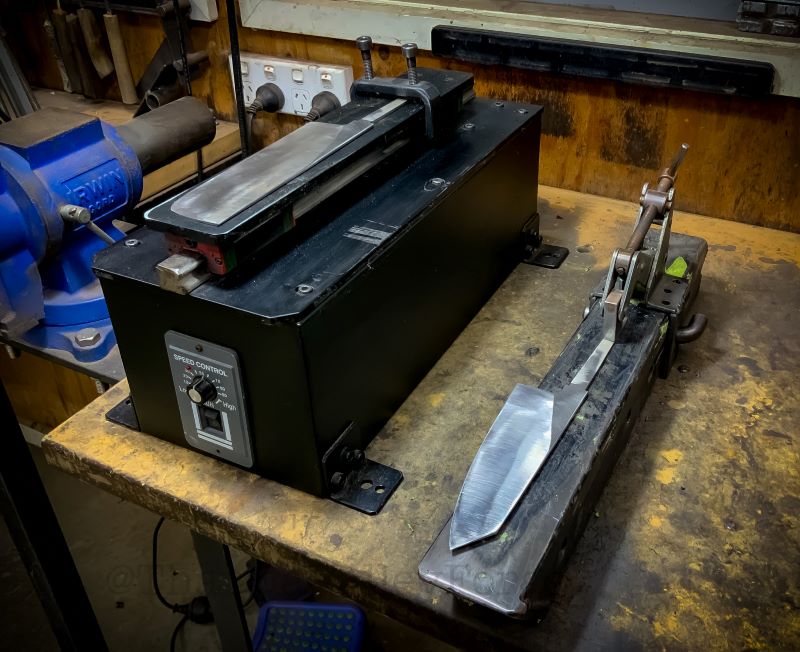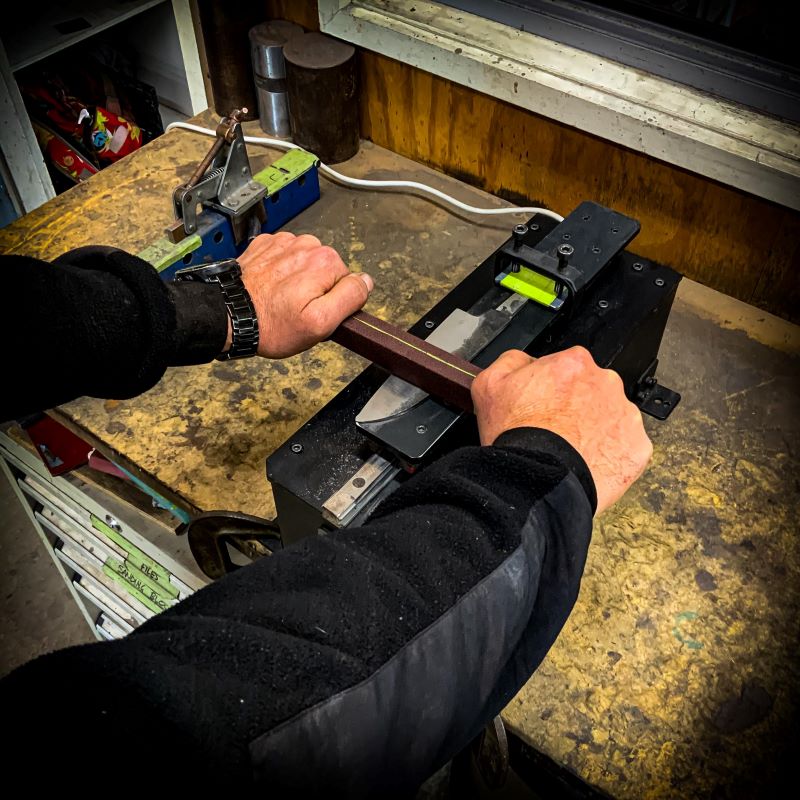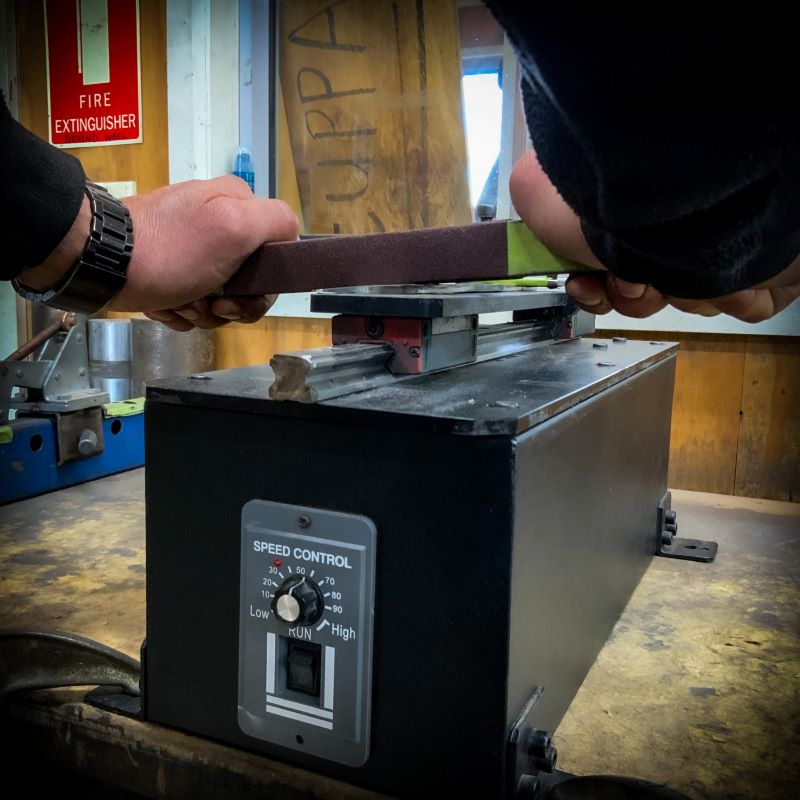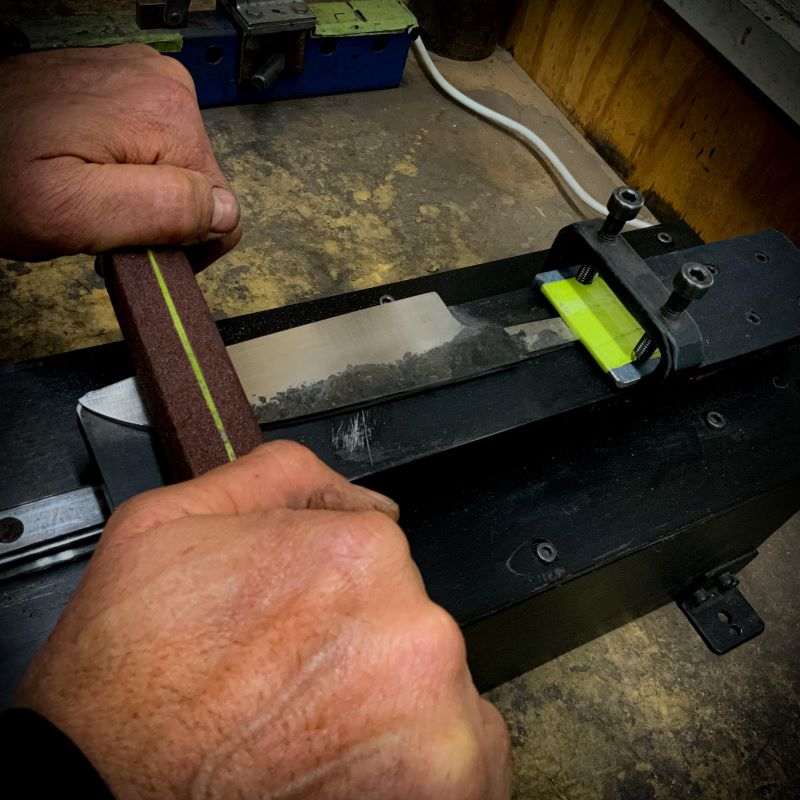 Knife makers often disagree on many things, but there’s a near-universal dislike for the tedious task of hand sanding blades. While it’s true that spending hours in focused work can be rewarding, the repetitive motions involved in hand sanding can be problematic for those with injuries or mobility issues and simply exhausting for most. Marcin Grabowiec from MG-Forge has tackled this issue head-on with his innovative hand sanding machines, the Finn 1.0.
Knife makers often disagree on many things, but there’s a near-universal dislike for the tedious task of hand sanding blades. While it’s true that spending hours in focused work can be rewarding, the repetitive motions involved in hand sanding can be problematic for those with injuries or mobility issues and simply exhausting for most. Marcin Grabowiec from MG-Forge has tackled this issue head-on with his innovative hand sanding machines, the Finn 1.0.
The Visionary Behind the Innovation
Marcin Grabowiec, a talented knifemaker based in Hanoi, Vietnam, understands the challenges of hand sanding. His goal was to create a machine that would make this essential task easier and less physically demanding. We recently invested in the Finn 1.0 to support our staff and students, and it has proven to be a game-changer.
Getting Started with the Finn 1.0
 We purchased the Finn 1.0 for $650 USD (approximately $1000 AUD, depending on the exchange rate), including shipping. The machine took a few weeks to arrive since it was custom-built for us. It was shipped via FedEx from Vietnam and reached us within a week, well-packaged and ready to use.
We purchased the Finn 1.0 for $650 USD (approximately $1000 AUD, depending on the exchange rate), including shipping. The machine took a few weeks to arrive since it was custom-built for us. It was shipped via FedEx from Vietnam and reached us within a week, well-packaged and ready to use.
The Finn 1.0 is a robust steel box, weighing around 10 kg, with tabs for secure attachment to your workbench. Its compact size makes it ideal for small workshops without compromising on power or performance. It features a powerful 250W internal motor, available in configurations for both Australian and international power supplies. The motor drives a sliding platen on top of the unit, with a stroke distance of approximately 50mm and a built-in variable speed dial for adjusting the tempo. Once the machine is securely attached to the bench, you can clamp on your blade and start sanding.
Performance and Usability
The clamp system on the Finn 1.0 is simple yet versatile. We used small blocks of timber as spacers to keep thin tangs in place. The machine has a significant amount of kick, so it needs to be firmly clamped to the bench. You can use any abrasive materials you typically hand sand with, including polishing stones and sandpaper with hard or soft backing. We found it most efficient to use the machine while standing, allowing us to press down with our upper body weight. It can also be used sitting down, though it’s less effective.
One important consideration is dust generation. The Finn 1.0 quickly creates a lot of dust, so using oil or water to keep it down is advisable. We applied duct tape to the sides for easier cleaning. The variable speed can be set very high, so ensure the blade is securely fastened. We usually ran it at about one-third speed and achieved a consistent finish.
Versatility and Advanced Features
 The Finn 1.0 isn’t limited to small or medium blades. Unlike other hand sanding machines with external drive arms, Marcin has incorporated the drive arm into the unit’s body. This design allows for clearance at the back of the platen, enabling users to extend blades past the back of the machine. This feature is ideal for sanding long blades like swords and sabers. It also allows you to affix blades with attached handles by clamping them off the rear edge, making it perfect for restoring old blades without risking damage to the handles.
The Finn 1.0 isn’t limited to small or medium blades. Unlike other hand sanding machines with external drive arms, Marcin has incorporated the drive arm into the unit’s body. This design allows for clearance at the back of the platen, enabling users to extend blades past the back of the machine. This feature is ideal for sanding long blades like swords and sabers. It also allows you to affix blades with attached handles by clamping them off the rear edge, making it perfect for restoring old blades without risking damage to the handles.
The Next Evolution: Finn 2.0
Marcin has since released the Finn 2.0, which features a variable stroke length adjustable via a turnbuckle. This upgrade makes on-the-fly adjustments easy, though the exposed mechanism might catch something in the workshop if proper safety precautions aren’t taken. This model may also limit the blade length, but it remains a significant improvement for those needing more control over the stroke length.
Our Experience at the Forge
The Finn 1.0 has been incredibly beneficial at our forge. It helps our less able-bodied students finish hand sanding their blades during classes and speeds up our blade processing for production runs and large client orders, saving wear and tear on our arms.
Is it faster than hand sanding? Not necessarily, but it’s far less tiring. We can sand many more blades in a day and still feel good at the end. A final hand-sanding pass is still necessary, but the machine handles the bulk of the work. It’s particularly useful for makers with arthritis or those who find hand sanding too physically demanding. The finish quality is as good as hand-sanding.
Conclusion
 Marcin Grabowiec’s Finn 1.0 and Finn 2.0 are transformative tools for any knife maker’s workshop. They reduce the physical strain of hand sanding and maintain a high-quality finish. For more information and to see these machines in action, visit MG-Forge’s website.
Marcin Grabowiec’s Finn 1.0 and Finn 2.0 are transformative tools for any knife maker’s workshop. They reduce the physical strain of hand sanding and maintain a high-quality finish. For more information and to see these machines in action, visit MG-Forge’s website.